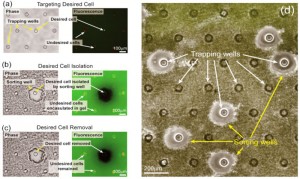Image-based Sorting of Cells
- Category: MEMS & BioMEMS
- Tags: joel voldman, tao sun
Microfluidic approaches to cell sorting include purely dielectrophoretic (DEP) trap arrays [1] , passive hydrodynamic trap arrays with active DEP-based cell release [2] , and passive microwell arrays with optical cell release to permit sorting of non-adhered cells [3] . As in the preceding technologies, we developed an image-based single-cell sorting method that enables parallel cell sorting using a dual-photopolymerization scheme. Our approach enables simultaneously sorting multiple cells of interest following high-resolution imaging with high purity using a method that requires only common equipment at modest cost. Our overall approach was to spatially segregate cells using a microwell array, image them, and then remove desired cells from the array by encapsulating all the undesired cells in a photopolymer (see Figure 1). To demonstrate the sorting of minority populations (e.g., rare cell isolation), we mixed the GFP- and mCherry-expressing cells at a ratio of 1:100 and targeted to sort the GFP-expressing cells, while RFP-expressing cells were undesired. First, the desired GFP-expressing cells were targeted via microscopy (as Figure 2a shows). The desired GFP-expressing cell in the center was isolated from its surrounding mCherry-expressing cells by the photopolymerized PEGDA sorting well, while the undesired mCherry-expressing cells were encapsulated in the cross-linked gel (in Figure 2b, the gel is autofluorescent in the green channel). Finally, the desired GFP-expressing cells were removed by simply washing the array, leaving the undesired mCherry-expressing cell (see Figure 2c). Figure 2d shows a 1 mm × 1.4 mm region of the array after the desired cells were sorted. The two layers of microwells are evident: the trapping wells made from the photopolymerized optical adhesive and the sorting wells made from the photopolymerized PEGDA hydrogel. The overall technique requires standard equipment found in biological labs and inexpensive reagents (<$10 per experiment), encouraging widespread adoption.
- Figure 1: Schematic of sorting method.
- Figure 2: We loaded a mixture of mCherry+ and GFP+ Hela cells into the device (a) Phase and fluorescence close-up images of a desired GFP+ cell in the midst of undesired mCherry+ cells. (b) Images of the array after the photopolymerization, showing the desired GFP+ cells are isolated from undesired cells mCherry+ cells by the PEGDA polymer sorting well. (c) Images of the array showing the desired cell removed by washing the dish. (d) View of the array showing trapping and sorting wells.
- J. R. Kovac, B. M. Taff, and J. Voldman, “Enabling technologies for image-based cell sorting,” in Methods in Bioengineering, M. Yarmush, R. Langer, Eds. 2009. [↩]
- B. M. Taff, S. P. Desai, and J. Voldman, “Electroactive hydrodynamic weirs for micro-particle manipulation and patterning,” Applied Physics Letters, vol. 94, no. 8, p. 084102, 2009. [↩]
- J. R. Kovac and J. Voldman, “ Intuitive, image-based cell sorting using opto-fluidic cell sorting,” Analytical Chemistry, vol. 79, pp. 9321-9330, 2007. [↩]

